Sudipen
Sudipen (Southern Ilocano pronunciation: [su'dipɯn]), officially the Municipality of Sudipen (Ilocano: Ili ti Sudipen; Filipino: Bayan ng Sudipen), is a 4th class municipality in the province of La Union, Philippines. According to the 2020 census, it has a population of 17,187 people.[3]
Sudipen | |
|---|---|
| Municipality of Sudipen | |
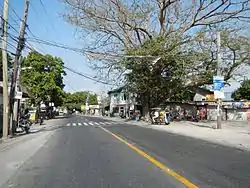 Downtown area | |
 Flag  Seal | |
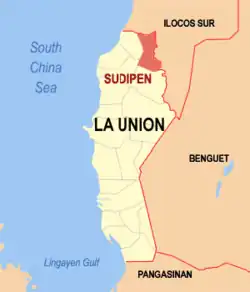 Map of La Union with Sudipen highlighted | |
OpenStreetMap | |
.svg.png.webp) Sudipen Location within the Philippines | |
| Coordinates: 16°54′N 120°28′E | |
| Country | Philippines |
| Region | Ilocos Region |
| Province | La Union |
| District | 1st district |
| Barangays | 17 (see Barangays) |
| Government | |
| • Type | Sangguniang Bayan |
| • Mayor | Wendy Joy D. Buquing |
| • Vice Mayor | Melvin G. Macusi |
| • Representative | Pablo C. Ortega |
| • Municipal Council | Members |
| • Electorate | 13,973 voters (2022) |
| Area | |
| • Total | 97.59 km2 (37.68 sq mi) |
| Elevation | 70 m (230 ft) |
| Highest elevation | 443 m (1,453 ft) |
| Lowest elevation | 0 m (0 ft) |
| Population (2020 census)[3] | |
| • Total | 17,187 |
| • Density | 180/km2 (460/sq mi) |
| • Households | 4,238 |
| Economy | |
| • Income class | 4th municipal income class |
| • Poverty incidence | 3.95 |
| • Revenue | ₱ 95.82 million (2020) |
| • Assets | ₱ 367.6 million (2020) |
| • Expenditure | ₱ 134.2 million (2020) |
| • Liabilities | ₱ 50.42 million (2020) |
| Service provider | |
| • Electricity | La Union Electric Cooperative (LUELCO) |
| Time zone | UTC+8 (PST) |
| ZIP code | 2520 |
| PSGC | |
| IDD : area code | +63 (0)72 |
| Native languages | Kankanaey Ilocano Tagalog |
| Website | www |
History
By virtue of Executive Order No. 72 signed by President Manuel Roxas on July 30, 1947, the municipal district of Sudipen, along with San Gabriel and Pugo, was organized into a regular municipality. As a result, the fourteen municipalities of La Union, all established under the Revised Administrative Code, were increased to seventeen.[5]
Geography
Sudipen is located 312 kilometres (194 mi) north-north-west of the Philippine capital, Manila, and 43 kilometres (27 mi) away from the provincial capital of San Fernando, La Union. It is bounded on the west by the municipalities of Bangar and Balaoan; on the east and north by the Amburayan River and the province of Ilocos Sur; and in the south by Santol.
Sudipen has a total land area of 97 square kilometers, making it the fifth largest municipality by land area in the province. [6] Barangay Bulalaan is the largest barangay with a land area of 8,988 hectares (22,210 acres), while Barangay Poblacion is the smallest with only 82 hectares (200 acres).
Barangays
Sudipen is politically subdivided into 17 barangays. [6] Each barangay consists of puroks and some have sitios.
- Bigbiga
- Bulalaan
- Castro
- Duplas
- Ilocano
- Ipet
- Maliclico
- Namaltugan
- Old Central ('Nagpanaoan)
- Poblacion
- Porporiket
- San Francisco Norte
- San Francisco Sur
- San Jose
- Sengngat
- Turod
- Up-uplas
Climate
| Climate data for Sudipen, La Union | |||||||||||||
|---|---|---|---|---|---|---|---|---|---|---|---|---|---|
| Month | Jan | Feb | Mar | Apr | May | Jun | Jul | Aug | Sep | Oct | Nov | Dec | Year |
| Average high °C (°F) | 30 (86) |
31 (88) |
33 (91) |
33 (91) |
32 (90) |
31 (88) |
30 (86) |
30 (86) |
30 (86) |
31 (88) |
31 (88) |
31 (88) |
31 (88) |
| Average low °C (°F) | 20 (68) |
21 (70) |
23 (73) |
25 (77) |
26 (79) |
25 (77) |
25 (77) |
25 (77) |
25 (77) |
23 (73) |
22 (72) |
21 (70) |
23 (74) |
| Average precipitation mm (inches) | 27 (1.1) |
31 (1.2) |
40 (1.6) |
71 (2.8) |
207 (8.1) |
237 (9.3) |
286 (11.3) |
261 (10.3) |
261 (10.3) |
254 (10.0) |
88 (3.5) |
46 (1.8) |
1,809 (71.3) |
| Average rainy days | 9.4 | 9.3 | 12.7 | 17.0 | 25.4 | 26.8 | 27.4 | 26.1 | 25.0 | 21.0 | 15.5 | 10.6 | 226.2 |
| Source: Meteoblue[7] | |||||||||||||
Demographics
| Year | Pop. | ±% p.a. |
|---|---|---|
| 1918 | 3,569 | — |
| 1939 | 6,039 | +2.54% |
| 1948 | 6,922 | +1.53% |
| 1960 | 7,926 | +1.13% |
| 1970 | 9,785 | +2.13% |
| 1975 | 10,430 | +1.29% |
| 1980 | 10,796 | +0.69% |
| 1990 | 13,043 | +1.91% |
| 1995 | 14,075 | +1.44% |
| 2000 | 15,099 | +1.52% |
| 2007 | 15,949 | +0.76% |
| 2010 | 16,531 | +1.31% |
| 2015 | 17,056 | +0.60% |
| 2020 | 17,187 | +0.15% |
| Source: Philippine Statistics Authority[8][9][10][11] | ||
In the 2020 census, the population of Sudipen was 17,187 people,[3] with a density of 180 inhabitants per square kilometre or 470 inhabitants per square mile.
Economy
Government
Local government
Sudipen, belonging to the first congressional district of the province of La Union, is governed by a mayor designated as its local chief executive and by a municipal council as its legislative body in accordance with the Local Government Code. The mayor, vice mayor, and the councilors are elected directly by the people through an election which is being held every three years.
Elected officials
| Position | Name |
|---|---|
| Congressman | Pablo C. Ortega |
| Mayor | Wendy Joy D. Buquing |
| Vice-Mayor | Melvin G. Macusi |
| Councilors | Tita D. Mostoles |
| Edwin M. Belisoa Jr. | |
| Joebet L. Dee | |
| Demy L. Danguecan | |
| Thelma R. Peña | |
| Bery A. Yadao | |
| Marcelina P. Leonen | |
| Yna P. Castro | |
Gallery
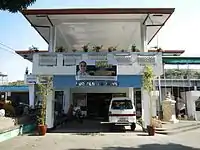 Municipal hall
Municipal hall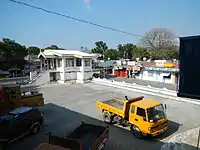 Town center
Town center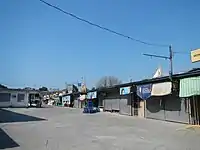 Sudipen Farmers Public Market
Sudipen Farmers Public Market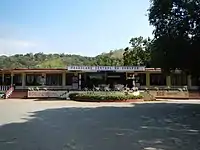 Sudipen Central School
Sudipen Central School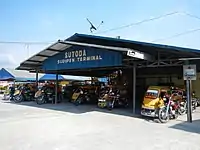 Sudipen terminal
Sudipen terminal
References
- Municipality of Sudipen | (DILG)
- "2015 Census of Population, Report No. 3 – Population, Land Area, and Population Density" (PDF). Philippine Statistics Authority. Quezon City, Philippines. August 2016. ISSN 0117-1453. Archived (PDF) from the original on 25 May 2021. Retrieved 16 July 2021.
- Census of Population (2020). "Region I (Ilocos Region)". Total Population by Province, City, Municipality and Barangay. Philippine Statistics Authority. Retrieved 8 July 2021.
- "PSA Releases the 2018 Municipal and City Level Poverty Estimates". Philippine Statistics Authority. 15 December 2021. Retrieved 22 January 2022.
- "Executive Order No. 72, s. 1947". Official Gazette (Philippines). Government of the Philippines. 30 July 1947. Retrieved 20 March 2023.
- "Province: La Union". PSGC Interactive. Quezon City, Philippines: Philippine Statistics Authority. Retrieved 12 November 2016.
- "Sudipen: Average Temperatures and Rainfall". Meteoblue. Retrieved 26 April 2020.
- Census of Population (2015). "Region I (Ilocos Region)". Total Population by Province, City, Municipality and Barangay. Philippine Statistics Authority. Retrieved 20 June 2016.
- Census of Population and Housing (2010). "Region I (Ilocos Region)" (PDF). Total Population by Province, City, Municipality and Barangay. National Statistics Office. Retrieved 29 June 2016.
- Censuses of Population (1903–2007). "Region I (Ilocos Region)". Table 1. Population Enumerated in Various Censuses by Province/Highly Urbanized City: 1903 to 2007. National Statistics Office.
- "Province of La Union". Municipality Population Data. Local Water Utilities Administration Research Division. Retrieved 17 December 2016.
- "Poverty incidence (PI):". Philippine Statistics Authority. Retrieved 28 December 2020.
- "Estimation of Local Poverty in the Philippines" (PDF). Philippine Statistics Authority. 29 November 2005.
- "2003 City and Municipal Level Poverty Estimates" (PDF). Philippine Statistics Authority. 23 March 2009.
- "City and Municipal Level Poverty Estimates; 2006 and 2009" (PDF). Philippine Statistics Authority. 3 August 2012.
- "2012 Municipal and City Level Poverty Estimates" (PDF). Philippine Statistics Authority. 31 May 2016.
- "Municipal and City Level Small Area Poverty Estimates; 2009, 2012 and 2015". Philippine Statistics Authority. 10 July 2019.
- "PSA Releases the 2018 Municipal and City Level Poverty Estimates". Philippine Statistics Authority. 15 December 2021. Retrieved 22 January 2022.
- "2019 National and Local Elections" (PDF). Commission on Elections. Retrieved 6 March 2022.